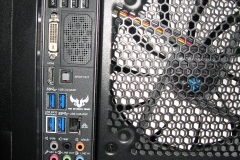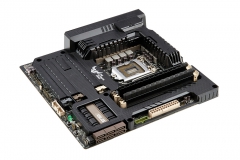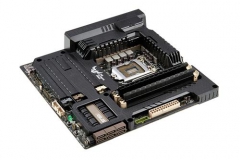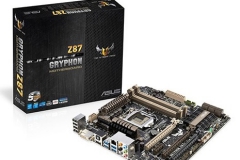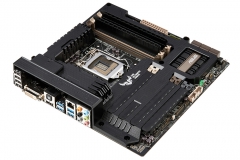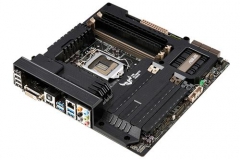Accessories
ASUS also include the following accessories in the package:
- User’s manual
- ASUS Q-Shield (shown below)
- 4 x SATA 6Gb/s cables
- 1 x SLI bridge
- 1 x Q-connector
- 1 x TUF Certification card(s)
- 1 x TUF 5 Year Warranty manual
- 1 x TUF Inside sticker
Nothing over the top but everything you need to get started. The only thing we thought might have been nice was another 2 SATA cables but the inclusion of 4 is pretty standard for motherboards these days.
Optional Armor Kit
The Gryphon Z87 is a good offering on its own and ASUS has given the consumer the choice of a well priced, SLI capable micro ATX motherboard loaded with highly durable components with the option of stretching another $50-55 to deck the board out with a thermal armor kit to make it even more durable. The kit consists of:
- Top armor plate
- Bottom armor plate
- 40mm fan
- Dust slot covers
- Rear IO connection covers
- 3 thermal probes
- Screw driver
- Instruction manual
The ASUS Gallery shots are below
Our box opening shots of the armor kit are below. Note the solid metal base and light plastic top with 40mm fan that can be swapped out if desired.
Installation
The armor is fitted with the board upside down, screws going in from the metal base plate to the top plastic shroud. The instructions were easy to follow and the installation took about 10 minutes with me ambling along and taking my time. The result looks pretty good and means that the motherboard should suit just about any case theme with any lighting or accessories because its black.
A 40mm fan?
The 40mm fan is really important to maintaining airflow under the top armor cover but it doesn’t have to work hard to be effective. In ‘silent’ mode, the fan is not audible once windows has started. The fan is audible on boot as it ramps up and until a fan profile kicks in – the fan can also be configured to run post shutdown for a user defined period of time to cool components after they are powered down. It’s a neat option and although it’s difficult to say how much difference it makes in the long term, having the feature certainly won’t hurt. We tested the fan at the ‘silent’ setting and at full tilt, finding the difference on the VCORE and DRAM sensors to be around 3 degrees in favour of full speed but at an unacceptable acoustic penalty – that little fan make a lot of noise at full speed and in real world use, you should never need to have it above audible. Under the ASUS Silent and Standard settings, the fan had a positive effect and was either inaudible or barely audible despite how warm we tried to make the case.
Protection
Thermally, the armor kit offers a slight improvement. Initially on the open air test bench, I couldn’t detect any tangible thermal benefit, so much so that I removed the armor and repeated the testing on the ‘naked’ board again. Sure enough, no difference – so I tested it in the way that it was meant to be used, in a case. In the case, I found that there was an improvement to component temperatures when the airflow of the case was reduced, the CPU/GPU both maxed out and the internal case temperature increased to around 37 degrees. The difference as about 5 degrees on the VCORE, VCORE (Black) and DRAM sensors. The GPU slot sensors were about the same or within margin for error with the armor fitted or removed but this will vary depending on the GPU solution that you might use. The stock GTX580 exhausted air out the back and the Twin Frozr cooler on our GTX 760 didn’t see the GPU to get over 70 degrees.
In terms of dust, I didn’t use the Gryphon Z87 long enough to let it cake up but I can see how the covers will help on that front and ASUS include dust protectors for everything, USB headers, SATA ports, the lot.
Physical damage is something that I’m most interested in avoiding as it’s the most likely culprit due to the amount of times I have to ‘relocate’ motherboards or change components. When you are fitting an armor plated Gryphon Z87 into a case, it feels rugged and protected – and heavier.
Aesthetics are also important and the black plastic top plate has a checker plate pattern that once fitted makes the board “colour agnostic” in that you could match it with any lighting theme because it’s 95% black. There are hints of brown and beige visible but it’s mostly black flat surfaces but not enough to clash with a lighting theme. We used green and UV (that looks blue in the photos) because that was what we had available but a clean white, blue or red should also work out well.

